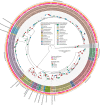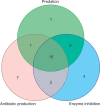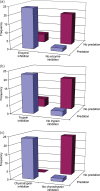Phylogenetic diversity and activity screening of cultivable Actinobacteria isolated from marine sponges and associated environments from the western coast of India
- PMID: 34712902
- PMCID: PMC8549387
- DOI: 10.1099/acmi.0.000242
Phylogenetic diversity and activity screening of cultivable Actinobacteria isolated from marine sponges and associated environments from the western coast of India
Abstract
The phylogenetic diversity of cultivable actinobacteria isolated from sponges (Haliclona spp.) and associated intertidal zone environments along the northern parts of the western coast of India were studied using 16S rRNA gene sequences. A subset of randomly selected actinobacterial cultures were screened for three activities, namely predatory behaviour, antibacterial activity and enzyme inhibition. We recovered 237 isolates from the phylum Actinobacteria belonging to 19 families and 28 genera, which could be attributed to 95 putative species using maximum-likelihood partition and 100 putative species using Bayesian partition in Poisson tree processes. Although the trends in the discovery of actinobacterial genera isolated from sponges were consistent with previous studies from different study areas, we provide the first report of nine actinobacterial species from sponges. We observed widespread non-obligate epibiotic predatory behaviour in eight actinobacterial genera and we provide the first report of predatory activity in Brevibacterium , Glutamicibacter , Micromonospora , Nocardiopsis , Rhodococcus and Rothia . Sponge-associated actinobacteria showed significantly more predatory behaviour than environmental isolates. While antibacterial activity by actinobacterial isolates mainly affected Gram-positive target bacteria with little or no effect on Gram-negative bacteria, predation targeted both Gram-positive and Gram-negative prey with equal propensity. Actinobacterial isolates from both sponges and associated environments produced inhibitors of serine proteases and angiotensin-converting enzyme. Predatory behaviour was strongly associated with inhibition of trypsin and chymotrypsin. Our study suggests that the sponges and associated environments of the western coast of India are rich in actinobacterial diversity, with widespread predatory activity, antibacterial activity and production of enzyme inhibitors. Understanding the diversity and associations among various actinobacterial activities - with each other and the source of isolation - can provide new insights into marine microbial ecology and provide opportunities to isolate novel therapeutic agents.
Keywords: antibiotic production; bacterial predation; enzyme inhibition; molecular phylogeny; secondary metabolites.
© 2021 The Authors.
Conflict of interest statement
The authors declare that there are no conflicts of interest.
Figures





Similar articles
-
Diversity and antimicrobial potential of Actinobacteria isolated from diverse marine sponges along the Beibu Gulf of the South China Sea.FEMS Microbiol Ecol. 2019 Jul 1;95(7):fiz089. doi: 10.1093/femsec/fiz089. FEMS Microbiol Ecol. 2019. PMID: 31210273
-
Diversity of Culturable Actinobacteria Producing Protease Inhibitors Isolated from the Intertidal Zones of Maharashtra, India.Curr Microbiol. 2020 Nov;77(11):3555-3564. doi: 10.1007/s00284-020-02174-1. Epub 2020 Sep 9. Curr Microbiol. 2020. PMID: 32902705
-
Diversity of culturable actinobacteria isolated from marine sponge Haliclona sp.Antonie Van Leeuwenhoek. 2007 Nov;92(4):405-16. doi: 10.1007/s10482-007-9169-z. Epub 2007 Jun 14. Antonie Van Leeuwenhoek. 2007. PMID: 17566868
-
Korean indigenous bacterial species with valid names belonging to the phylum Actinobacteria.J Microbiol. 2016 Dec;54(12):789-795. doi: 10.1007/s12275-016-6446-4. Epub 2016 Nov 26. J Microbiol. 2016. PMID: 27888457 Review.
-
Bioprospecting of unexplored halophilic actinobacteria against human infectious pathogens.3 Biotech. 2023 Dec;13(12):398. doi: 10.1007/s13205-023-03812-8. Epub 2023 Nov 14. 3 Biotech. 2023. PMID: 37974926 Free PMC article. Review.
Cited by
-
Longitudinal Analysis of the Microbial Community on the Surface of Bloodstains Under Different Environmental Conditions in Areas with Minimal Human Interference.Curr Microbiol. 2024 Aug 16;81(10):307. doi: 10.1007/s00284-024-03833-3. Curr Microbiol. 2024. PMID: 39150477
-
Antiproliferative activity of antimicrobial peptides and bioactive compounds from the mangrove Glutamicibacter mysorens.Front Microbiol. 2023 Feb 17;14:1096826. doi: 10.3389/fmicb.2023.1096826. eCollection 2023. Front Microbiol. 2023. PMID: 36876075 Free PMC article.
-
Identification and Characterization of a Multifunctional Biocontrol Agent, Streptomyces griseorubiginosus LJS06, Against Cucumber Anthracnose.Front Microbiol. 2022 Jun 2;13:923276. doi: 10.3389/fmicb.2022.923276. eCollection 2022. Front Microbiol. 2022. PMID: 35722317 Free PMC article.
-
A Metataxonomic Approach Reveals Diversified Bacterial Communities in Antarctic Sponges.Mar Drugs. 2021 Mar 22;19(3):173. doi: 10.3390/md19030173. Mar Drugs. 2021. PMID: 33810171 Free PMC article.
-
Characterization of Silver Carbonate Nanoparticles Biosynthesized Using Marine Actinobacteria and Exploring of Their Antimicrobial and Antibiofilm Activity.Mar Drugs. 2023 Oct 13;21(10):536. doi: 10.3390/md21100536. Mar Drugs. 2023. PMID: 37888471 Free PMC article.
References
LinkOut - more resources
Full Text Sources
Miscellaneous
